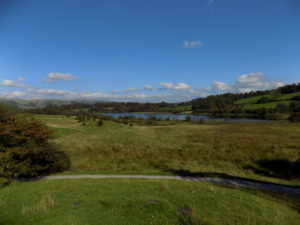Ministry of Flat Walks 27 : Blelham Tarn
29 August 2019
To follow this walk on a map, open another tab on your browser and go to this web address: https://bit.ly/2MGe2Yl.
John and I have done this walk a couple of times this year, but on the first occasion I waited too long to be able to write a blog. We had another go this weekend. I have used John’s photos from both days to illustrate this blog (thank you again, John) which is why the weather appears to change so much from one picture to the next.
Unlike many of the walks featured at the Ministry, this one is right in the heart of the Lake District, across the hillsides between Ambleside, Hawkshead and Lake Windermere. The route is about three and a half miles long. It’s undulating, rather than flat, but there are no severe gradients. Most of it is off the road, but long stretches are on well gravelled paths laid, I presume, by the National Park Authority. There are good signposts along the way.
 The walk starts near Wray Castle, a Gothic revival edifice some 180 years old which is now in National Trust hands and has been open to the public since 2011. John and I visited soon after it had been reopened, but at the time there was not much to see. It might be worth a return visit some time soon. The NT has converted it into a family activity centre, according to the website (https://www.nationaltrust.org.uk/wray-castle), and there will no doubt be hordes of children, but the building itself looks interesting. The photograph here is from Wikipedia.
The walk starts near Wray Castle, a Gothic revival edifice some 180 years old which is now in National Trust hands and has been open to the public since 2011. John and I visited soon after it had been reopened, but at the time there was not much to see. It might be worth a return visit some time soon. The NT has converted it into a family activity centre, according to the website (https://www.nationaltrust.org.uk/wray-castle), and there will no doubt be hordes of children, but the building itself looks interesting. The photograph here is from Wikipedia.
On the map, Lake Windermere is to the east, and Wray Castle is just inland, two thirds of the way up. A driveway leads westwards from the castle to the public road, passing a church and exiting through an imposing gateway. Some parking is available at the Castle (free to NT members), but there are also several parking places on the road near the gateway where you can leave your car. Alternatively this walk can be undertaken from Outgate, in the bottom left corner of the map, but parking there is less easy unless you use the pub car park. I have no idea whether they take steps to prevent use by non-patrons.
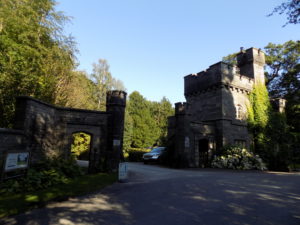 Starting at the Wray Castle gatehouse, walk southwards along the road until you come to the edge of the wood. There is a signpost here pointing along a path to the right. Follow this path, which goes through some trees and across a meadow down to a stone-flagged footbridge across a stream.
Starting at the Wray Castle gatehouse, walk southwards along the road until you come to the edge of the wood. There is a signpost here pointing along a path to the right. Follow this path, which goes through some trees and across a meadow down to a stone-flagged footbridge across a stream.
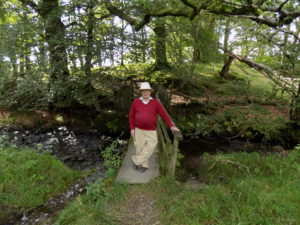 Cross the stream and continue along the path, which follows the left hand edge of meadowland. You will need to climb over a couple of stiles. At one point your route takes a right turn in front of a gate; look out for a yellow way marker on the gatepost.
Cross the stream and continue along the path, which follows the left hand edge of meadowland. You will need to climb over a couple of stiles. At one point your route takes a right turn in front of a gate; look out for a yellow way marker on the gatepost.
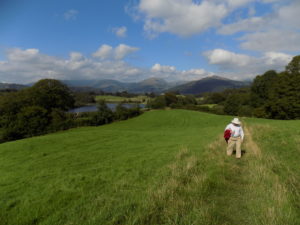 The path rises gently, crossing the middle of two more meadows, and becomes wider and rutted like a farm track where wheeled vehicles have occasionally passed. Looking back and to your right, you should have an excellent view across Blelham Tarn with the fells on the far side of Windermere in the background.
The path rises gently, crossing the middle of two more meadows, and becomes wider and rutted like a farm track where wheeled vehicles have occasionally passed. Looking back and to your right, you should have an excellent view across Blelham Tarn with the fells on the far side of Windermere in the background.
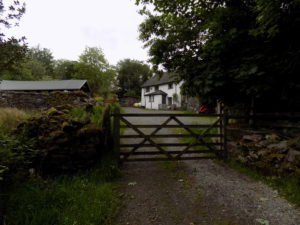 The track winds around a copse of trees and comes to a gate. Go through the gate and past a group of buildings to reach a minor road, joining from your left and leading straight ahead. To your right is a driveway leading downhill to Hole House. Continue straight ahead along the road for a hundred yards or so and then take a right fork on to another driveway, grit and cinders, which curves right towards the farm buildings at High Tock How. Just uphill on your left, before you reach the farm, is an area of rough ground where we found bits of farm machinery lying around. Go across this space and through an open gateway on the far side, then turn right along the side of the wall.
The track winds around a copse of trees and comes to a gate. Go through the gate and past a group of buildings to reach a minor road, joining from your left and leading straight ahead. To your right is a driveway leading downhill to Hole House. Continue straight ahead along the road for a hundred yards or so and then take a right fork on to another driveway, grit and cinders, which curves right towards the farm buildings at High Tock How. Just uphill on your left, before you reach the farm, is an area of rough ground where we found bits of farm machinery lying around. Go across this space and through an open gateway on the far side, then turn right along the side of the wall.
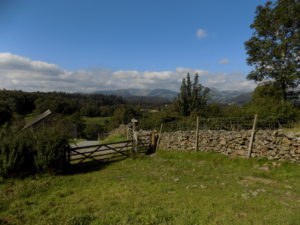 You will quickly come to a signpost with paths straight ahead and to the left. Continue straight on down the hill and through another gate to find another signpost. If you want a short cut you can go straight ahead here. Otherwise, turn left.
You will quickly come to a signpost with paths straight ahead and to the left. Continue straight on down the hill and through another gate to find another signpost. If you want a short cut you can go straight ahead here. Otherwise, turn left.
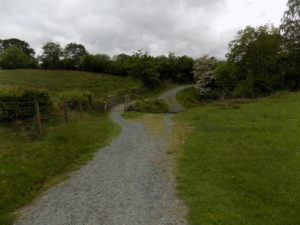 This is one of the National Park’s gravelled paths, easy to walk along and impossible to miss. You will cross a footbridge and come to yet another signpost, round the back of the buildings at Outgate, with paths to left and right. Turn right and go through two gates to reach the B5286 Hawkshead to Ambleside road. Immediately on your right is the Outgate Inn. John and I didn’t stop here, but it is a well-known watering place for hikers.
This is one of the National Park’s gravelled paths, easy to walk along and impossible to miss. You will cross a footbridge and come to yet another signpost, round the back of the buildings at Outgate, with paths to left and right. Turn right and go through two gates to reach the B5286 Hawkshead to Ambleside road. Immediately on your right is the Outgate Inn. John and I didn’t stop here, but it is a well-known watering place for hikers.
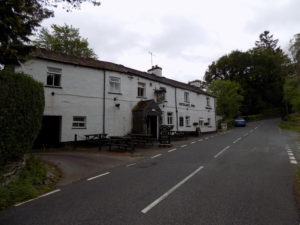 Turn right into the road, in the direction of Ambleside. Be careful: there are no pavements, the walls are high in places so visibility is restricted, and traffic here can be heavy at holiday time. Continue along the road until you come to the delimit signs, then turn on to the somewhat overgrown bridleway which leads off to the right.
Turn right into the road, in the direction of Ambleside. Be careful: there are no pavements, the walls are high in places so visibility is restricted, and traffic here can be heavy at holiday time. Continue along the road until you come to the delimit signs, then turn on to the somewhat overgrown bridleway which leads off to the right.
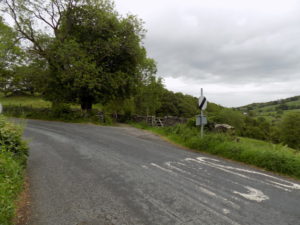 This is the most difficult part of the walk, as the footing is loose stones, rough with sharp edges and easy to trip over. The bridleway leads through woodland, with trees on both sides. On your right, you can again see Blelham Tarn, and beyond it the path across the meadows which you followed earlier.
This is the most difficult part of the walk, as the footing is loose stones, rough with sharp edges and easy to trip over. The bridleway leads through woodland, with trees on both sides. On your right, you can again see Blelham Tarn, and beyond it the path across the meadows which you followed earlier.
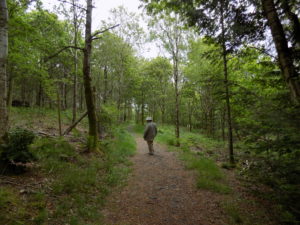 Your route climbs briefly uphill, then levels out and continues downhill for some distance. We found water running down the path here, evidently a stream which has diverted off the hillside on your left. The damp stones make the footing more insecure so, again, take care. Although the map suggests otherwise, you will find trees on both sides until you reach the bottom of the hill and join a gravelled path coming in from your right. This path is the short cut mentioned earlier.
Your route climbs briefly uphill, then levels out and continues downhill for some distance. We found water running down the path here, evidently a stream which has diverted off the hillside on your left. The damp stones make the footing more insecure so, again, take care. Although the map suggests otherwise, you will find trees on both sides until you reach the bottom of the hill and join a gravelled path coming in from your right. This path is the short cut mentioned earlier.
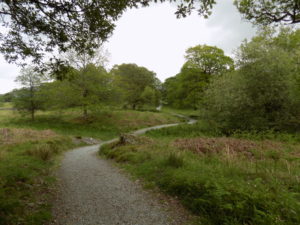 The rest of the walk is straightforward. Simply follow the path across heathland for half a mile or so. The map shows a ford half way along this stretch, but it is out of date; there is now a footbridge. Eventually another path comes in from the left, signposted to Ambleside. You continue to the right, now paralleling the road until you come out at Low Wray Bridge, where a lane diverges to the left, signposted to the camp site at Low Wray. Continue to follow the road up the hill and back to your parking place. This is the steepest section of the walk but I did not find it too difficult. Perhaps it helps to have the end of the walk so closely in view.
The rest of the walk is straightforward. Simply follow the path across heathland for half a mile or so. The map shows a ford half way along this stretch, but it is out of date; there is now a footbridge. Eventually another path comes in from the left, signposted to Ambleside. You continue to the right, now paralleling the road until you come out at Low Wray Bridge, where a lane diverges to the left, signposted to the camp site at Low Wray. Continue to follow the road up the hill and back to your parking place. This is the steepest section of the walk but I did not find it too difficult. Perhaps it helps to have the end of the walk so closely in view.
At no point along the way will you approach the edge of Blelham Tarn itself. From a distance the tarn adds beauty to the landscape, but if you come close you may find the water clogged with blue-green algae. The tarn is eutrophic and the algae are poisonous, so keep out.
Perhaps my regular readers are wondering why there have been no recent reports from the Ministry of Flat Walks. Since the start of June I have had problems with my legs – mostly my left leg, but for a week or so the right leg too. Last weekend was the first time since early June that I have been up to the Lake District. Hence, no new walks.
There are other things to be done in the Lakes besides walking. If I never walked another mile I would still enjoy the scenery and the food, and of course John’s company too. But the prospect of an uncomfortable five-hour journey each way has been quite a strong disincentive.
The problems began around the time of the Cadogan Hall concert (see my blog of 19 June) and may in fact have been caused by it. I developed sharp pains running down my left leg, from my hip to my ankle, not in the joints or on the skin but right in the middle of the leg. I now think that the immediate cause may have been the long periods I spent standing still during rehearsal and performance. But this was not apparent at the time.
My first recourse was the NHS website, which is very helpful once you work out what question to ask. My symptoms corresponded very closely to its description of sciatica (https://www.nhs.uk/conditions/sciatica), which includes an excellent short animation explaining the condition and its likely causes. I had always previously assumed that sciatica was one of those layman’s terms, like lumbago, which have no strict meaning. But in fact it is a very specific condition caused by the sciatic nerve becoming trapped. The website says that the condition may resolve itself over time, with or without painkillers, but advises sufferers to consult their GP if it persists.
By the following weekend, when John and I went up to Cark together, where David and his friends were already staying, I was in a lot of discomfort walking, (especially) standing still, and even sitting or lying down if I didn’t find the right posture. David gave me a few tablets of a drug called meloxicam which he happened to have with him, and which did ease the pain a bit. But he was only able to give me just enough to last until he went back to Australia and I returned to Oxted. He also told me very plainly that I needed to see the GP straight away, and so I arranged an urgent appointment as soon as I returned home.
The local GP practice is at Oxted Health Centre which, unlike many other practices in the cash-strapped NHS, still assigns each patient to an individual GP. Mine is Dr Green. However, the rule is that while you can book routine appointments with your assigned GP (you may have to wait a fortnight), for a same-day consultation you are seen by whoever happens to be on duty that day. I had the misfortune on this occasion to be seen by a doctor whom I didn’t know at all. I think he may have been a locum as his name is not listed anywhere at the Centre. I’m going to call him Dr Sanni; it was something like that.
I described my symptoms without suggesting a diagnosis – from experience I know that not all doctors take it kindly when you do their job for them. I also felt a bit inhibited about asking him for a repeat prescription for meloxicam, which I probably would have done with Dr Green. In any case he didn’t offer either a diagnosis or painkillers. He just said I was getting old and should expect more aches and pains; and he suggested I pick up a self-referral form for physiotherapy at the reception desk. And that was that.
Now, I should have stifled my resentment, filled in the form and sent it off. But I didn’t. The NHS website warns that the physiotherapy service can be very slow, and perhaps at the back of my mind was a fear that by the time I’d arranged an appointment I would already be feeling better and would just have wasted everybody’s time. But I’m not sure that is the whole reason. As for paying for a private consultation which could be arranged sooner, I confess the thought didn’t even occur to me.
Instead I relied on the advice on the website which basically says the sciatica usually gets better on its own; and so it has done, though more slowly than the estimated 4-6 weeks. In the meanwhile I made sure that I got my usual exercise (which the website recommends) walking around Oxted, as I usually do, but I avoided longer trips.
I consulted various other friends and relatives and their suggestions were, I thought, quite illuminating of different world views. David, the doctor, said I should get more effective painkillers. (Not paracetamol, which is useless for this type of pain, or ibuprofen, which doesn’t combine well with some of my other medicines.) Georgina suggested I should go to a chiropractor; but, coming from a medical family, I am sceptical about alternative medicine. My one experience with a complementary treatment, using a Chinese herbal remedy for eczema, left me worse off than before. Another friend, Frances, berated me soundly and said I should have paid for private physiotherapy. On reflection of course she was right, but a lifetime of NHS medicine made this a difficult leap for me.
Anyway, things have gradually got better. I can lie down without pain, and I have been walking in the Lake District (see next blog). Unfortunately the sciatica has left other problems in its wake. Georgina and John have both told me that I have started walking with a bit of a limp, turning my left foot out at an angle. And I have been feeling pains in my left ankle, shin and knee. I am pretty sure (and David tells me this is likely to be true) that these symptoms have all been caused by the unconscious changes I made in my gait so as to minimise the effects of the sciatica. They should wear off with time; but in the meanwhile I have to be more mindful of how I walk.
While all this was going on, one Sunday I suddenly developed a different problem with my right foot. In the evening, when I took my shoes off, I found a fierce rash, purple and a little raw, around my right heel and ankle. It had not been there in the morning. I thought it might be caused by either cellulitis or shingles. Obviously I needed to go to the GP, who on this occasion was Dr O’Connor, one of the resident team at the Health Centre. She took one look and told me I had developed varicose eczema (https://www.nhs.uk/conditions/varicose-eczema) , for which the treatment is the same as the atopic eczema from which I have suffered, on and off, all my life: emollients and steroid creams, applied regularly for a week.
Dr O’Connor reassured me that there was no connection with the sciatica (I had been worried about that), but was unable to suggest a specific cause. Varicose eczema, like varicose veins, may be caused by poor circulation, which gave Dad a great deal of discomfort in his last few years. But my circulation is fine. The only thing I could think of was that I had been wearing a pair of tight socks – some of my socks are tight enough to leave an indentation around my leg when I take them off. So I have invested in some gentle grip socks, and will phase out the others.
For about a week my right foot, heel and ankle were swollen enough that it was difficult to put on any of my shoes. I spent most of the week pottering around the house barefoot. The rash slowly subsided and has now disappeared completely. If it happens again I shall know what to do.
In fantasy literature, notably Ursula LeGuin’s Earthsea series, you gain power over people and things if you know their true names. This isn’t just fiction. I was happier with Dr O’Connor who put a name to my symptoms than with Dr Sanni who didn’t. This is the power not of magic but of reassurance. If a condition can be named then it’s less frightening; doctors know about it, and can help you to deal with it.
Someone needs to tell Dr Sanni.
——————–
Another Measure
22 August 2019
 Last weekend we went to Stratford-on-Avon to see the RSC’s latest production of Measure for Measure. John and I still have clear memories of the idiosyncratic Donmar production from only a few months ago (see my blog of 17 November 2018), but Chris and Janet, rather to my surprise, had never previously seen the play.
Last weekend we went to Stratford-on-Avon to see the RSC’s latest production of Measure for Measure. John and I still have clear memories of the idiosyncratic Donmar production from only a few months ago (see my blog of 17 November 2018), but Chris and Janet, rather to my surprise, had never previously seen the play.
This new RSC production, directed by Greg Doran, is fairly orthodox. It has been edited sufficiently to prevent the play’s subplots, involving the pimps, bawds and other lowlifes of Vienna, from overwhelming the main plot, and to keep to a running time of two and a half hours, which seems to be some kind of unofficial target at Stratford these days. But most of the directorial intrusions which have marred some recent RSC shows are here mercifully absent.
After an opening ballroom scene in appropriate costumes to announce the setting as fin-de-siècle Vienna, the stage set, props and costumes are more or less anonymous and gimmick-free. For most of the time we could as easily be in Vilnius or Valparaiso. Shakespeare’s geography, we know, was rudimentary (in The Winter’s Tale, notoriously, he gives Bohemia a coastline): all he requires is that the location should be sufficiently exotic for us to accept the play’s extreme premise that, in order to quell persistent licentiousness, a prohibition on extramarital sex will be strictly enforced. As a result Claudio is sentenced to death for getting his fiancée Juliet pregnant. Even in Shakespeare’s own time this must have been quite hard to swallow. But it sets up the necessary conflict between law, morality and mercy which is the play’s central theme.
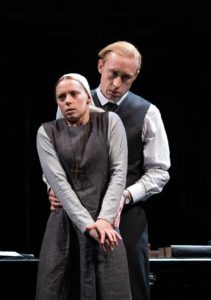 Chris and Janet were particularly struck by the drama of the play’s two key confrontations: between Angelo and Isabella, then between Isabella and Claudio. The argument does not go all one way, though Angelo eventually undermines his own case by his indecent proposal to Isabella, and Isabella’s reluctance is vindicated when it becomes apparent that he intends to double-cross her.
Chris and Janet were particularly struck by the drama of the play’s two key confrontations: between Angelo and Isabella, then between Isabella and Claudio. The argument does not go all one way, though Angelo eventually undermines his own case by his indecent proposal to Isabella, and Isabella’s reluctance is vindicated when it becomes apparent that he intends to double-cross her.
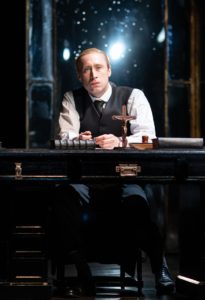 Sandy Grierson is excellent as Angelo, and succeeds in giving this apparently villainous character a human quality. You can see he scarcely believes what he has done, nor understands the passions which have driven him to it. Grierson is on his way to becoming an RSC stalwart: we have seen him several times now, in Dido Queen of Carthage, Doctor Faustus and Twelfth Night, and he has been really good each time.
Sandy Grierson is excellent as Angelo, and succeeds in giving this apparently villainous character a human quality. You can see he scarcely believes what he has done, nor understands the passions which have driven him to it. Grierson is on his way to becoming an RSC stalwart: we have seen him several times now, in Dido Queen of Carthage, Doctor Faustus and Twelfth Night, and he has been really good each time.
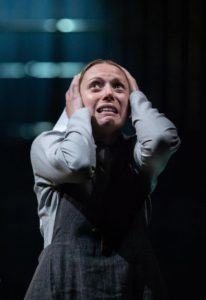 I was a little less convinced by Lucy Phelps as Isabella, although it’s only fair to say that Chris and Janet were more impressed. Perhaps I was spoiled by seeing Hayley Atwell at the Donmar, a performance I can hardly imagine being bettered by anyone. But Phelps’ Isabella had for me a bit too much flavour of drama school, Isabella-by-the-numbers, reacting to the words on the page rather than creating a fully formed character. And there were a couple of moments which felt completely out of place, notably when she waved her arms aloft in momentary triumph, like a spectator celebrating a goal but very unlike the nun that she is supposed to be. I doubt very much whether she was following her director’s instructions at this moment, although Doran has to take a share of the blame for allowing her to do it.
I was a little less convinced by Lucy Phelps as Isabella, although it’s only fair to say that Chris and Janet were more impressed. Perhaps I was spoiled by seeing Hayley Atwell at the Donmar, a performance I can hardly imagine being bettered by anyone. But Phelps’ Isabella had for me a bit too much flavour of drama school, Isabella-by-the-numbers, reacting to the words on the page rather than creating a fully formed character. And there were a couple of moments which felt completely out of place, notably when she waved her arms aloft in momentary triumph, like a spectator celebrating a goal but very unlike the nun that she is supposed to be. I doubt very much whether she was following her director’s instructions at this moment, although Doran has to take a share of the blame for allowing her to do it.
Only at the very end does Phelps show something more, in her wordless expression of incredulous horror when the Duke, at the end of it all, asks her – twice! – to marry him. On the briefest of acquaintances. What was Shakespeare thinking of at this moment? It reminds me of the ending of The Taming of the Shrew, when Kate turns submissive: hard for a modern audience to take at face value, but hard, too, for us to be sure whether Shakespeare ever intended us to do so.
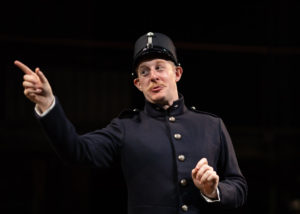 This is not the only point at which MfM plays a bit like a retread of earlier Shakespeare hits. The way it splices together comedy and painful dilemma is very reminiscent of The Merchant of Venice. The hapless constable Elbow, who is prominent in the subplots during the first half of the play, is close kin to the equally bumbling Dogberry in Much Ado. The character of Angelo is one of Shakespeare’s most interesting and complex, but by the end I was wondering whether he is intended as a caricature of the Puritan enemies of the theatre, like Malvolio in Twelfth Night but sharper and more bitter. And the final scene of MfM inescapably echoes any number of concluding scenes from the other comedies, though here it is given a sour twist as only one of the wedded couples seem really happy with each other.
This is not the only point at which MfM plays a bit like a retread of earlier Shakespeare hits. The way it splices together comedy and painful dilemma is very reminiscent of The Merchant of Venice. The hapless constable Elbow, who is prominent in the subplots during the first half of the play, is close kin to the equally bumbling Dogberry in Much Ado. The character of Angelo is one of Shakespeare’s most interesting and complex, but by the end I was wondering whether he is intended as a caricature of the Puritan enemies of the theatre, like Malvolio in Twelfth Night but sharper and more bitter. And the final scene of MfM inescapably echoes any number of concluding scenes from the other comedies, though here it is given a sour twist as only one of the wedded couples seem really happy with each other.
 Shakespeare’s original audience no doubt recognised these self-borrowings and were amused by them. They probably cared less about things that bother us more, like the character of the Duke, whose behaviour is inconsistent and, by the end, frankly incomprehensible. He is not so much a character as a puppet who does whatever the author requires him to do. The one way to make sense of him is to treat him as a bit of a joke, and that is how Doran has directed Antony Byrne to play him. It’s a valiant effort, but frankly with this man in charge it’s no wonder that Vienna is a bit of a mess.
Shakespeare’s original audience no doubt recognised these self-borrowings and were amused by them. They probably cared less about things that bother us more, like the character of the Duke, whose behaviour is inconsistent and, by the end, frankly incomprehensible. He is not so much a character as a puppet who does whatever the author requires him to do. The one way to make sense of him is to treat him as a bit of a joke, and that is how Doran has directed Antony Byrne to play him. It’s a valiant effort, but frankly with this man in charge it’s no wonder that Vienna is a bit of a mess.
This interpretation is at least consistent with Doran’s overall view of the play which brings out its comedy as much as its drama. To begin with I found the various goings-on among the Viennese lowlife rather tedious. There is the usual difficulty keeping track of Shakespeare’s minor characters and the relationships between them; and Elbow (Michael Patrick) is more tiresome than funny.
 But after the interval the comedy is actually amusing. The ludicrous and boastful Lucio (Joseph Arkley) slanders the Duke to Friar Ludowick, not realising that Duke and Friar are the same person, and duly gets his come-uppance: a good, if rather obvious, performance by Arkley.
But after the interval the comedy is actually amusing. The ludicrous and boastful Lucio (Joseph Arkley) slanders the Duke to Friar Ludowick, not realising that Duke and Friar are the same person, and duly gets his come-uppance: a good, if rather obvious, performance by Arkley.
Then the boisterous stinking no-good Barnadine (Graeme Brookes) narrowly escapes being executed in Claudio’s place because none of the prison warders wants, or perhaps dares, to approach him. This is a genuinely amusing turn by Brookes and it’s a shame we don’t see more of him.
As with other recent shows, and in line with current RSC policies which Greg Doran himself initiated as Artistic Director, the casting of the show is colourblind. That seems fair enough, as MfM’s Vienna is plainly something of a melting-pot. There is also some cross-casting in the roles of Escalus (played by Claire Price), the Provost (Amanda Harris) and some other minor parts. The gender shift works well here (though I wish they had changed Escalus’s name: -us is a masculine name-ending in any Latinate language, and I found this detail jarring), and Price, in particular, is excellent.
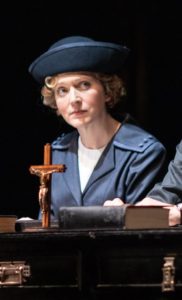 Escalus is not an easy role. He/she offers a voice of moderation in a play where moderation is in short supply, and yet he/she allows him/herself to be overruled by his/her political masters, the Duke and then Angelo. Shakespeare intends him to be a wise old man, a faithful lieutenant. But the cross-casting introduces a sexual undercurrent too as Price’s Escalus is clearly just a little starry-eyed over the Duke, which helps to explain how she continues to believe in the Duke’s and Angelo’s goodness, right up to the last moment. A wise old man would surely have developed a little more cynicism than this.
Escalus is not an easy role. He/she offers a voice of moderation in a play where moderation is in short supply, and yet he/she allows him/herself to be overruled by his/her political masters, the Duke and then Angelo. Shakespeare intends him to be a wise old man, a faithful lieutenant. But the cross-casting introduces a sexual undercurrent too as Price’s Escalus is clearly just a little starry-eyed over the Duke, which helps to explain how she continues to believe in the Duke’s and Angelo’s goodness, right up to the last moment. A wise old man would surely have developed a little more cynicism than this.
I realise that I am in danger of damning this MfM with faint praise, which would be a little unfair. It’s not an easy play, and I enjoyed it well enough. The key confrontations are well done, and Grierson is excellent throughout. But I think I had higher expectations from Greg Doran, who is a top class director when he puts his mind to it. By comparison with his best work, this production feels just a little routine.

